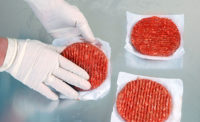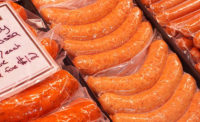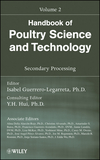Packaging for Safety
By Richard Mitchell
Packaging provides many features for meat and poultry products, but enhancing food safety is among the major attributes.
The constant struggle to produce and distribute meat and poultry in microbial-reduced or microbial-free environments is leading processors, packers, and retailers to incorporate advanced operating strategies. And the package is becoming an increasingly vital element in their food-safety initiatives.
With more organizations positioning films, bags, casings, and other packaging elements as protection, and in some instances weapons, against listeria, salmonella, E.coli O157:H7, and other pathogens, product manufacturers are upgrading their lines with robust packaging materials that are designed to withstand higher temperatures and stresses, and in some instances support the inclusion of antimicrobials.
While health issues have always been key industry concerns, a tighter focus on food safety by regulatory agencies and consumers is helping spur interest in more sophisticated packaging, analysts say.
“The growth we’re seeing in case-ready meats is partly due to retailers’ concerns about food safety, and companies also are focusing on temperature controls, antimicrobial films, and are offering more secure seals on packages,” says Huston Keith, principal of Keymark Associates, a Marietta, GA-based market research and business development consulting firm specializing in packaging. “While food safety often involves the food preparation process, packaging provides a further safeguard.”
Such mechanisms include the use of resilient bags to support post-pasteurization, a procedure for killing microbials on the surface of beef and poultry after packaging. Products undergoing the process typically are immersed in hot water, placed in a cabinet with condensing steam, or given a hot-water shower. Temperatures usually range from 160Þ F to 210Þ F, and the activity can last from 30 seconds to 15 minutes, depending on the temperature.
Advanced packaging
Technology suppliers are responding with a wide range of products and services. Curwood Inc., an Oshkosh, WI-based packaging developer, is marketing its Surface Post Pasteurization, or SPP, bags that contain a sealant layer designed to withstand temperatures of 210Þ F for up to 10 minutes without softening or breaking. The bags also are printed with inks that resist abrasions in the hot and high-pressure conditions.
The company is also producing shrink bags with a “Lift and Peel” flap. As part of the overwrap seal, the flap rises so deli operators can access meat and poultry without having to cut through the film with a knife. The feature is intended to reduce the threat of contamination, which can occur when a dirty utensil comes in contact with food.
Multi-layer bags also feature an oxygen barrier to help extend the shelf life of deli service counter meats. And the products, which carry “Surround” brand, are designed so graphics can be printed on every part of the film to give a billboard appearance.
Packages are also being developed to support high-pressure pasteurization, a procedure in which meat often is subjected to 40,000 pounds-per-square inch of pressure at the packing plant prior to shipment.
Alcan Packaging, a Chicago-based manufacturer, is marketing shrink bags that are formulated to withstand the stresses from high-pressure and post-pasteurization, and is also testing the effectiveness of film with antimicrobial elements in eradicating bacteria in packages.
During trials with several customers, Alcan found that the antimicrobials are primarily capable of just eliminating pathogens on those parts of meat that come into direct contact with the film. While Alcan calls this “a very positive step” toward minimizing bacteria on the surface of meats, such products as sliced lunch meats in shingled containers and packages of hot dogs — in which much of the food does not touch the film—are poor candidates for the procedure.
Government encouragement
Helping to generate processor interest in such food-safety elements is a rule first published by the U.S. Department of Agriculture’s Food Safety and Inspection Service (FSIS) in June 2003 that encourages plants to incorporate technologies that can kill the bacteria or prevent its growth after cooking and packaging. The measure is designed to drive down the rate of listeria in ready-to-eat meat and poultry products.
The rule requires all establishments producing ready-to-eat goods that are exposed to the environment after cooking to develop written programs to control listeria and to verify the effectiveness of those programs through testing.
Plants that use steam pasteurization and other processes to kill listeria inside a package do not need to test product contact surfaces because the meat and poultry would not be exposed to the environment after cooking, FSIS states.
FSIS adds that a recently completed survey of ready-to-eat establishments reveals that they “have responded to the rule appropriately and have strengthened and intensified their programs to control listeria.”
Casings enhance food safety
Among the elements being leveraged for greater safety are casings that enable processors to cook and deliver meat without removing products from the coverings. The casings lessen the risk of contamination because food is not rehandled prior to shipping.
To improve the flavor of meat and poultry while also protecting the food from contamination, Oak Brook, IL-based Inovpack Vector Inc. is providing plastic casings that are coated with liquid smoke. The products are part of the company’s Enhance series that includes its SmokeKote and ColorKote lines of casings. ColorKote provides color to products via the casing to enhance the meat’s appearance.
While permeable, or fibrous, casings have historically been popular in the meat and poultry sector, those coverings typically are not as effective as the plastic impermeable products in shielding products from microbials, analysts say.
Controlling pathogens often requires the use of bags and casings that are strong enough to withstand extreme heat and pressure. Duncan, SC-based Cryovac/Sealed Air Corp. is marketing its polyolefin-based CNP-310 high-shrink and high-gloss bag that features resins that enable it to handle temperatures of up to 210Þ F during post-pasteurization activity, says Jeff Rhodehamel, Cryovac/Sealed Air research and development manager for poultry, seafood, and cook-in packaging.
Cryovac’s line of casings includes its CNT-115 color transfer product, which releases color-coding to the meat’s surface during cooking to enhance the food’s presentation. After cooking, the products are shipped in the same casings so the chance of cross-contamination from handling is eliminated.
Atlanta-based Gold Kist Inc., a leading chicken processor, is leveraging technologies that create more tightly sealed packages. Prior to shipment, Gold Kist products are encased in two pieces of film that are then welded together to help keep bacteria from contaminating chickens and to prevent leakage.
The package is then shrink wrapped for further protection, says Greg Moore, Gold Kist marketing director. “The chicken is sealed better so it can’t be contaminated from the outside, he notes.
Case-ready solutions
Other food-safety elements becoming more prevalent include zero-oxygen, case-ready packages — which keeps meat fresher longer and creates an environment that makes it almost impossible for aerobic bacteria to thrive — and reclosable zippers.
While zippers typically are designed to keep retail deli meats and other products fresher after containers are opened, they also provide a shield that helps to guard package contents from bacteria, says Tom Winter, product manager for Appleton, WI-based Presto Products Co.’s Fresh-Lock brand of zippers.
“The safety and health issues have always been important to the meat and poultry industry, and companies now are looking at presenting products in new ways while still meeting food-safety requirements,” he notes. NP
Technology suppliers participating in this article include:
Alcan Packaging, phone (773) 399-8513, fax (773) 399-3330, e-mail lisa.apolinski@alcan.com, or visit www.alcanpackaging.com
Cryovac/Sealed Air Corp., phone (864) 433-2000 or (800) 845-3456, fax (864) 433-2134, e-mail mkt@sealedair.com, or visit www.cryovac.com
Curwood Inc., phone (920) 303-7300 or (800) 544-4672, fax (920) 303-7227, e-mail: curwood@bemis.com, or visit www.curwood.com
Inovpack Vector Inc., phone: (630) 434-0040 or (800) 435-9100, fax (630) 434-9100, e-mail: inovpackvector@aol.com, or visit www.inovpackvector.com
Presto Products, phone (920) 738-1344 or (800) 265-0750, fax (920) 738-1347, e-mail: fresh-lock@alcoha.com, or visit www.Fresh-Lock.com
Richard Mitchell is a Chicago-area freelance writer.








